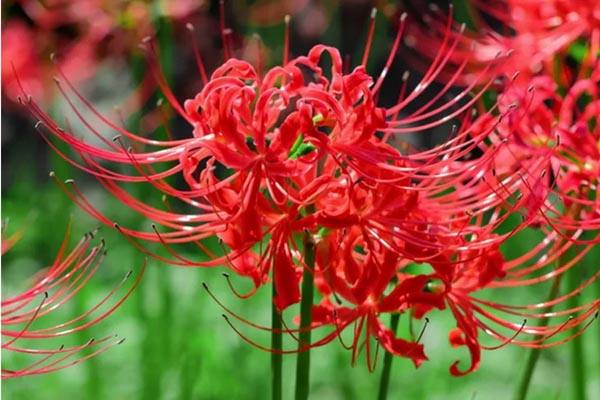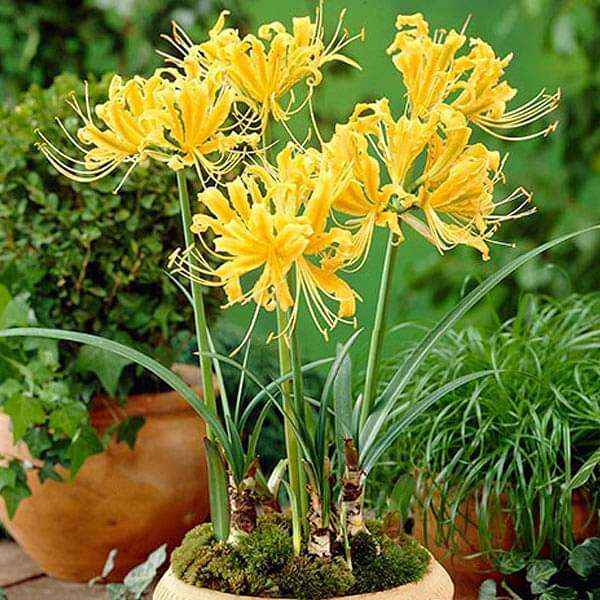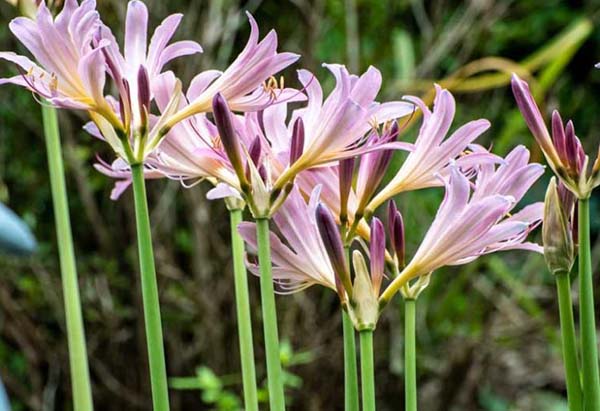Lycoris (Spider lily)
Spider lily is the common name of numerous plants, including those of the small Lycoris genus. Spider lilies are known for their striking blooms. They feature thin, delicate petals and long stamens, which result in flowers that resemble spider legs-hence the plant's common name.
Lycoris is a genus of 13–20 species of bulbous flowering plants in the family Amaryllidaceae. In the wild, spider lilies can be found in Japan, Korea, China, and Iran. They were imported into United States and now grow wild.
Lycoris has an unusual development cycle – leaves appear in spring, and during hot summer weather, they wither away, creating the impression that the plant has died. If watering is resumed after a period of dormancy, flower stalks with amazingly beautiful flowers suddenly emerge from the soil. This is because in the wild, these plants follow a life cycle dictated by the climate – cool and moist spring, hot and dry summer, followed by a rainy period when beautiful flowers bloom. This is why lycoris is called the resurrecting lily, surprise lily, magic lily. It gets another common name, Hurricane Lily, from the fact that it blooms during the stormy season in Asia.

Spider lilies are dormant from the midspring to midsummer months, but they grow quickly after they sprout. The blooms emerge on a tall, naked stem in the late summer to fall. Blue-green foliage follows after the flowering is finished and remains until spring.
Lycoris Species
There are about 20 known species of lycoris. All species have narrow and long leaves, reaching 30-60 cm in length. The above-ground stem is erect, 30-70 cm tall. Flowers come in two types depending on the species: those with long stamens much longer than the petals (Lycoris radiata), and those with stamens of the same length as the petals (Lycoris squamigera, Lycoris sanguinea).
Lycoris radiata, or the red spider lily, is a bulbous perennial plant with striking bright red flowers, also known as red spider lily or red magic lily. Native to China, Japan, and Korea, it blooms in late summer or fall, often in response to abundant rainfall. Four to six flowers, arranged in umbels, are located at the top of each plant stem. The plant retains its leaves during winter and spring but sheds them as soon as the air temperature starts to rise. If there are no leaves, it's better not to water Lycoris.

Lycoris aurea, or golden spider lily, is a bulbous perennial plant with attractive umbels of 5-6 golden-yellow flowers with wavy edges, adorned with elegantly curled petals and protruding stamens. Each umbel can reach 8 inches (20 cm) in diameter. It blooms from late summer to early fall, and fleshy, strap-shaped leaves appear after flowering.

Lycoris squamigera can be found in Southeast China and Korea. This bulbous plant has simple basal leaves that grow in spring and wither in June, while flowers appear in late July or early August. The flowers are white or pink and fragrant, suddenly emerging from the ground in mid to late summer.

Lycoris sanguinea is native to Japan and China. The leaves are narrow, no more than 1.5 cm wide. The flower stalk produces 4-6 red flowers with a diameter of about 8 inches.
How to Grow Lycoris at Home

Lycoris is an undemanding plant when grown in the garden – a 'plant it and forget it' type that surprises with beautiful flowers. However, it does not tolerate severe frost and may not always survive winter even under a layer of mulch. To grow spider lilies at home and witness their flowers, it is essential to consider the life cycle of the plant: lycoris differs from many other amaryllids in that it always flowers in a leafless state. The dormant period occurs during the summer months; around June, the leaves completely dry up, and the plant seems to sleep during the hottest time of the year. In late August to early September, flower stalks emerge from the soil, bearing usually several flowers.
Light: Bright, indirect light. During dormancy, it can be moved to any warm, dry place. If planted in the garden, make sure it does not get soaked in rain.
Temperature: Normal summer temperatures; in winter, it is advisable to create cooler conditions not exceeding 64°F (18°C).
Water: During leaf growth, water generously, keeping the soil moist but allowing it to dry out before the next watering. From the onset of leaf withering until the appearance of flower stalks, do not water. Resume watering gradually during flowering.
Repotting: Dislikes frequent repotting. Repot occasionally when the plant no longer fits in the pot. It is better to do this in the fall. Do not dig up bulbs during the dormant period.
Soil: Light, well-draining, slightly acidic soil. Example soil mix: 1 part loam, 1 part peat, 1 part sand. Unlike hippeastrum, lycoris bulbs are completely covered with soil.
Fertilizer: Feed every 2 weeks spring to fall with a balanced water-soluble fertilizer.
Propagation: Propagate through daughter bulbs – each bulb divides into two annually, separate them after flowering. After division, lycoris takes quite a while to root, and it may not bloom in the same year.




